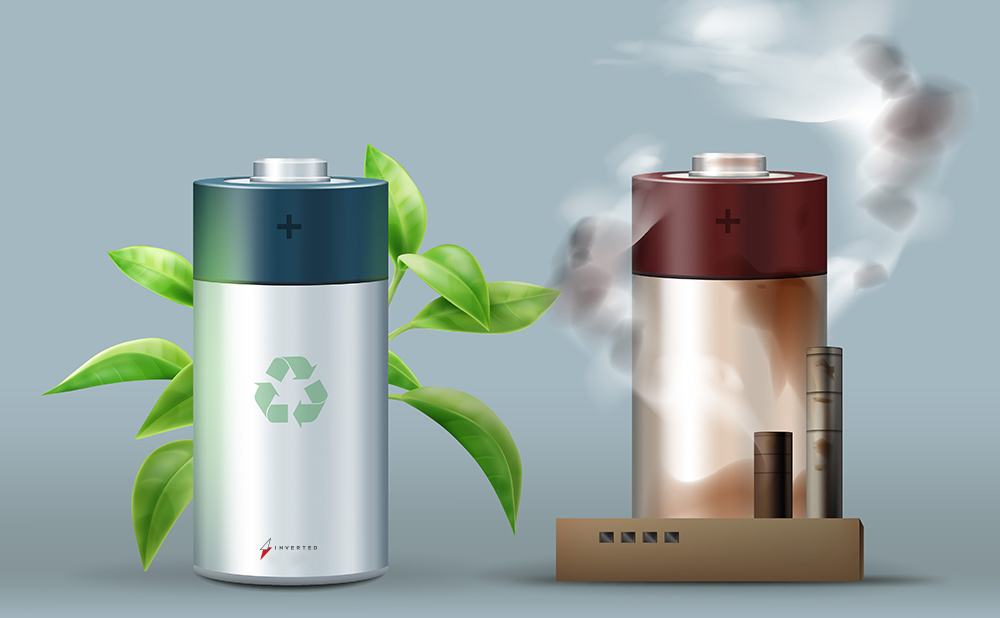Li-ion batteries have a higher energy density, higher cell voltage, low self-discharge and very good cycle life, and are environmentally friendly as well as simple to charge and maintain. There are times when a longer battery life, an increased number of charge cycles or a safer battery is more important than battery capacity.
Almost every component of the battery degrades over time, including the anode, cathode, electrolyte, separator and current collectors. There are two main forms of battery degradation: Capacity Fade and Power Fade. Capacity fade is a decrease in the amount of energy a battery can store, and power fade is a decrease in the amount of power it provides.
Advantages of extending Battery lifetime:
- Decreases costs and environmental burdens associated with the production of new batteries
- Reduces material consumption
- Reduces mining impacts
- Reduces greenhouse gas emissions
- Reduces disposal of used batteries
Boosting Battery Life
Usually, a combination of following factors increases or decreases battery life. Following factors will help in increased cycle life:

Comparison of Voltage Drop Rate with Respect to Discharge Rate Comparison of Voltage Drop Rate with Respect to Discharge Rate
- Charging
This is the most important thing to be careful about. The battery degradation is predominantly caused by charging. How fast you charge, at what temperature you charge, and till what SOC (State of Charge) you charge will determine the cycle life. Depth of discharge (DOD) is another factor that will affect the life of the battery. Thus, if charging and DOD are controlled then battery will have a very good life and give maximum bang for your buck.
- Lower charge voltages prolong battery life
Most Li-ions charge to 4.20V/cell, and every reduction in peak charge voltage of 0.10V/cell is said to double the cycle life. For example, a lithium-ion cell charged to 4.20V/cell typically delivers 300–500 cycles. If charged to only 4.10V/cell, the life can be prolonged to 600–1,000 cycles; 4.0V/cell should deliver 1,200–2,000 and 3.90V/cell should provide 2,400–4,000 cycles.
On the negative side, a lower peak charge voltage reduces the capacity the battery stores. But many a times, a longer battery life is more important than charge capacity.
- Charge rate: Lower the charge rate better
It takes more time to charge the battery with lower C rate (Charge current/Battery Ah), but batteries generally like to be charged as slow as possible. With 40 km range, most of the batteries will get charged in 3 to 4 hours without any issue. It is recommended to charge the battery at 0.3c or lower (0.3c = ah rating of the battery *0.3). This can be controlled easily by checking the amp rating of the charger.
Fast chargers might seem convenient, but high currents will heat and degrade a battery faster than a slow trickle charge. The same goes for high discharge rates.
- Charge Temperature: Charging battery in hot or cold temp is bad for cycle life
25 to 30-degree Celsius is the best temperature to charge your battery at. When battery is used, it often heats up. As almost all two-wheeler battery packs are sealed type with no cooling, the battery temperature inside will be higher after usage. So do not plug in immediately after using the battery. If you keep it for an hour or so before starting to charge, then that will give battery enough time to reach the room temp. If air conditioning is on, then that will even allow battery to reach its optimal charging temp of 25 to 30 degree Celsius.
- Batteries hate being too full or too empty
Ideally, we should never let batteries charge over 80 percent or discharge to less than 20 percent, because being outside the 80-20 percent range, on either side, stresses and degrades a lithium-ion battery. If the endurance of a fully-charged battery is needed, then a full charge is recommended – but take the device off the charger straight away once it hits 100 percent.
- Storage temperature: Keep the battery at room temperature
Avoiding direct sunlight and hot temp is important to extend the battery life. Try to store the battery during or after charging at room temp closer to 25 to 30-degree Celsius. Temperature extremes can accelerate degradation of almost every battery component. For vehicles without removal battery, park the vehicle in shade away from direct sunlight and heat. If you plan to not use the vehicle for some time, then better to keep the battery at 50% or lower SOC. This practice will help reduce the calendar fade of the battery.



Leave A Comment